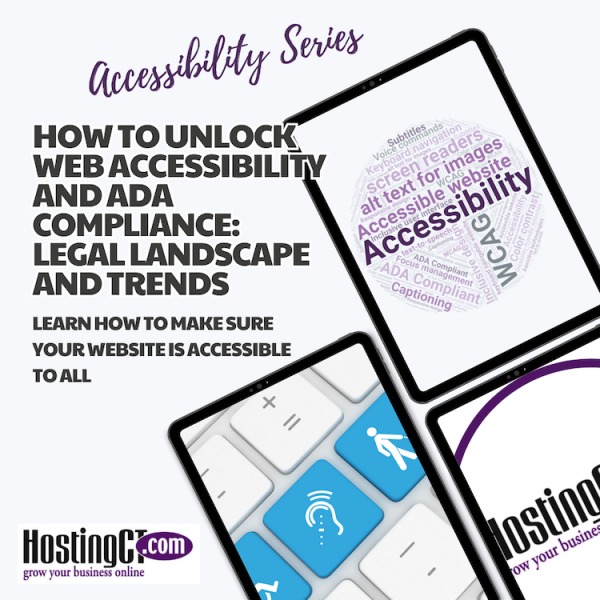How to Unlock Web Accessibility and ADA Compliance: Legal Landscape and TrendsSep182023

In today's digital age, web accessibility has become a crucial aspect of online presence. Ensuring that websites are accessible to individuals with disabilities is not only a moral responsibility but also a legal requirement. The Americans with Disabilities Act (ADA) has set the foundation for web accessibility regulations, and as technology advances, the importance of adhering to these regulations has become more significant than ever before.
1. Understanding ADA and Its Scope
The Americans with Disabilities Act (ADA) was enacted in 1990 to prohibit discrimination based on disabilities. Initially designed for physical spaces, it has evolved to encompass digital spaces as well. ADA ensures that individuals with disabilities have equal access to information, services, and opportunities, including those available online. This involves the use of multi-media in our digital offerings that may be outside our normal product and services scope.
2. The Significance of Web Accessibility
Web accessibility goes beyond mere compliance. It's about creating an inclusive online environment where everyone, regardless of their abilities, can access and interact with content seamlessly. Accessibility benefits not only people with disabilities but also the aging population and those using various devices to access the web. How often have you seen people taking pictures of signs so they can read them on their tablets? This is becoming commonplace.
3. Legal Requirements for Web Accessibility
Title III of the ADA mandates that businesses open to the public, including websites, must provide accessible services. While the ADA itself doesn't explicitly mention websites, courts have interpreted it to cover online platforms. Additionally, the Web Content Accessibility Guidelines (WCAG) set forth by the Web Accessibility Initiative (WAI) offer a globally recognized standard for web accessibility. Here is the fundamentals: https://www.w3.org/WAI/fundamentals/
4. Lawsuit Trends and Case Studies
In recent years, there has been a surge in lawsuits related to web accessibility. Companies that fail to make their websites accessible can face legal action. Notable cases include lawsuits against major retailers, educational institutions, and even government agencies for inaccessible websites, highlighting the need for compliance.
5. Steps to Achieve Web Accessibility
To ensure web accessibility, businesses should follow WCAG guidelines (https://www.w3.org/WAI/standards-guidelines/), which cover areas such as perceivable content, operable interfaces, understandable information, and robust technology. Implementing accessible design elements, providing alternative text for images, and offering keyboard navigation are some key steps.
6. Web Accessibility Audits and Tools
Conducting regular web accessibility audits is essential. Various tools and software are available to help identify issues and suggest improvements. These audits should address color contrast, text readability, multimedia alternatives, and overall site navigation. Is HostingCT going to offer this service to our clients? If yes, please let’s have a downloadable document that has a checklist of the different software packages that a person can use. Or they can sign up for a seminar from us where we can teach them this information with an offer at the end for “Done for You” Services. What do you think?
7. Benefits of Web Accessibility Compliance
Web accessibility compliance isn't just about avoiding lawsuits. It opens up opportunities for businesses to tap into a larger market, improve user satisfaction, and enhance their brand reputation as champions of inclusivity. According to the World Health Organization (WHO), around 15% of the world's population has a disability. That’s 1.2 billion people! This translates to a significant potential audience that businesses can reach if their websites are accessible to all.
8. The Role of Developers and Designers
Developers and designers play a pivotal role in integrating accessibility features into websites from the ground up. By incorporating accessible coding practices and intuitive design, they can ensure a seamless experience for all users.
9. Educating Teams about Accessibility
Raising awareness about web accessibility is crucial for all team members involved in website development, content creation, and management. Training sessions can help them understand the significance of accessibility and how to implement it effectively. Is HostingCT going to offer such training to our clients as part of our ADA package? If yes, this needs to be stated here when the next one is or we set up a quarterly schedule, etc. This is a great place to promote our educational sessions for our clients.
10. Future Trends in Web Accessibility
As technology evolves, web accessibility will continue to adapt. Innovations such as voice-activated interfaces and improved assistive technologies will reshape the landscape of accessible web design. As of 2021, voice-activated virtual assistants like Amazon's Alexa, Apple's Siri, and Google Assistant were becoming more common. These assistants are integrated into smartphones, smart speakers, and other devices, making it easier for people to interact with technology using voice commands.
11. Impact on User Experience
Web accessibility directly correlates with user experience. A well-designed, accessible website is more user-friendly for everyone, resulting in longer visit durations, increased engagement, and higher conversion rates. This means you receive higher rates on lead generation and cash flow into your business.
12. Building an Inclusive Online Community
Web accessibility contributes to building an inclusive online community where all individuals can participate, interact, and contribute without barriers and building a raging fan base out of your clients is what we all wish for, right?.
13. Advocacy for Change
Advocacy groups and individuals are actively pushing for stronger web accessibility regulations and enforcement to ensure a more inclusive online environment for everyone such as: .Web Accessibility Initiative (WAI), National Federation of teh Blink (NFB), American Council of the Blind (ACB), Disability Rights Education & Defense Fund (DREDF).
Conclusion
In conclusion, ADA and web accessibility are intertwined, shaping the digital landscape with inclusivity in mind. Adhering to web accessibility guidelines not only ensures legal compliance but also fosters a sense of social responsibility. By making websites accessible to all, we create a more equitable online world, increase our engagement with our clients, and build the strong communities of support that we seek.
Webinar: "5 Positive Effects of ADA Compliant Websites" - Register Today
Digital accessibility and ADA compliance are critical for any business with an online presence. There are many benefits to having an accessible website beyond simply meeting legal requirements. Join HostingCT for our upcoming webinar "5 Positive Effects of ADA Compliant Websites" October 12th, 19th, or 26th to explore the five key ways an accessible website can improve your business. We'll discuss how an ADA compliant website opens you up to new markets, builds customer trust and loyalty, enhances SEO and conversions, futureproofs your online presence, and protects you legally. Whether you're just starting your website or looking to improve accessibility, you'll gain valuable insights. Reserve your spot today to ensure your business fully capitalizes on the advantages of digital accessibility. Let's work together to create a web that works for everyone! Register today!





